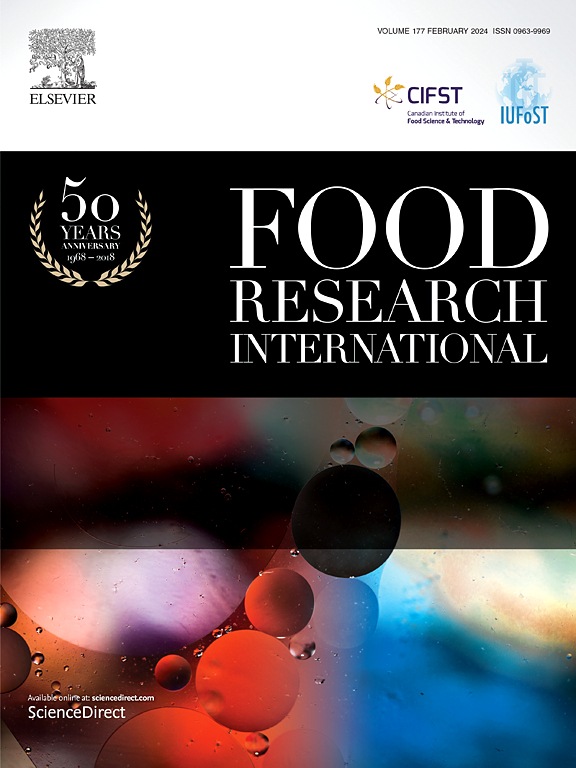Detection and genotyping of enteric foodborne viruses in ready-to-eat leafy vegetables and berries from Córdoba, Argentina
IF 8
1区 农林科学
Q1 FOOD SCIENCE & TECHNOLOGY
引用次数: 0
Abstract
The global consumption of ready-to-eat (RTE) leafy green vegetables and berries has risen as consumers perceive them as safe and nutritious options. However, these foods have also been identified as sources of enteric viruses that infect the human gastrointestinal system, which are then excreted and can spread through the fecal-oral route. In Argentina, there is limited evidence on the detection of enteric viruses in food, and no legislation currently requires their detection in frozen or fresh produce intended for domestic consumption. This study aimed to identify and characterize five foodborne viruses with high and low health impact (norovirus, hepatitis A virus, hepatitis E virus, rotavirus, and adenovirus) in berries and RTE leafy vegetables marketed in central Argentina. A total of 242 samples (145 berries and 97 leafy greens) were collected from retail sources in Córdoba and processed according to ISO 15216-2, 2019 standard. Viral detection was performed by qPCR or RT-qPCR, followed by viral characterization through specific RT-PCR assays or Sanger sequencing. Results indicate that 4.2 % (6/145) of berry samples, primarily frozen strawberries, tested positive for norovirus or rotavirus, while 10.3 % (10/97) of leafy green samples were positive for norovirus, rotavirus and adenovirus. Genotyping identified the same genotypes as those associated with local gastroenteritis outbreaks, and phylogenetic analysis showed that the strains were closely related. The absence of hepatitis A and E viruses suggests limited transmission of these pathogens through these foods. This study highlights the need to strengthen hygiene and monitoring protocols for RTE products, as viral contamination poses potential health risks to consumers, underscoring a critical area for improving food safety.

阿根廷Córdoba即食叶类蔬菜和浆果中肠道食源性病毒的检测和基因分型
即食绿叶蔬菜和浆果的全球消费量有所上升,因为消费者认为它们是安全和营养的选择。然而,这些食物也被确定为感染人类胃肠道系统的肠道病毒的来源,这些病毒随后被排出体外,并可通过粪-口途径传播。在阿根廷,关于在食品中检测肠道病毒的证据有限,目前也没有立法要求在供国内消费的冷冻或新鲜农产品中检测肠道病毒。本研究旨在鉴定和表征阿根廷中部销售的浆果和RTE叶菜中具有高低健康影响的五种食源性病毒(诺如病毒、甲型肝炎病毒、戊型肝炎病毒、轮状病毒和腺病毒)。共有242个样品(145个浆果和97个绿叶蔬菜)从Córdoba的零售来源收集,并根据ISO 15216- 2,2019标准进行处理。通过qPCR或RT-qPCR进行病毒检测,然后通过特异性RT-PCR测定或Sanger测序进行病毒鉴定。结果表明,4.2%(6/145)的浆果样品(主要是冷冻草莓)检测出诺如病毒或轮状病毒,10.3%(10/97)的绿叶蔬菜样品检测出诺如病毒、轮状病毒和腺病毒。基因分型鉴定出与当地肠胃炎暴发相关的基因型相同,系统发育分析显示菌株密切相关。没有甲型和戊型肝炎病毒表明这些病原体通过这些食物的传播有限。这项研究强调有必要加强RTE产品的卫生和监测协议,因为病毒污染对消费者构成潜在的健康风险,强调了改善食品安全的一个关键领域。
本文章由计算机程序翻译,如有差异,请以英文原文为准。
求助全文
约1分钟内获得全文
求助全文
来源期刊

Food Research International
工程技术-食品科技
CiteScore
12.50
自引率
7.40%
发文量
1183
审稿时长
79 days
期刊介绍:
Food Research International serves as a rapid dissemination platform for significant and impactful research in food science, technology, engineering, and nutrition. The journal focuses on publishing novel, high-quality, and high-impact review papers, original research papers, and letters to the editors across various disciplines in the science and technology of food. Additionally, it follows a policy of publishing special issues on topical and emergent subjects in food research or related areas. Selected, peer-reviewed papers from scientific meetings, workshops, and conferences on the science, technology, and engineering of foods are also featured in special issues.
 求助内容:
求助内容: 应助结果提醒方式:
应助结果提醒方式:


